 In June 2016, PMDG released the Douglas DC-6 Cloudmaster for X-Plane, their first foray into that platform. Early in the summer of 2017, the same classic airplane was released for FSX and P3D. Quite a bit different from the Boeing airliners PMDG released the last couple of years, so let’s see how they did.
In June 2016, PMDG released the Douglas DC-6 Cloudmaster for X-Plane, their first foray into that platform. Early in the summer of 2017, the same classic airplane was released for FSX and P3D. Quite a bit different from the Boeing airliners PMDG released the last couple of years, so let’s see how they did.
Douglas initially developed the DC-6 in response to a WWII USAAF requirement for a lengthened and pressurized version of the DC-4/C-54. Too late for the war, the aircraft was further developed for the civilian market, intended to compete with the Lockheed Constellation. The DC-6 first flew in 1946, and 704 examples in different variants were built before production ended in 1958. The DC-6 was further developed into the DC-7, but generally outlived its younger but less reliable stable mate. The PMDG DC-6 Cloudmaster models 2 variants: the DC-6A (cargo) and DC-6B (passenger).
Installation:
The PMDG DC-6 Cloudmaster is available for purchase in 4 versions. There are 2 for X-Plane, namely one for Windows users and one for Mac OS X users. At the time of writing, these are only supported in X-Plane 10, with no official X-Plane 11 support. The new releases, about which I’m writing this review, are a version for FSX (both boxed or the Steam Edition) and one for Prepar3D. The P3D version supports both P3Dv3 and P3Dv4. Prepar3D v2 is not supported. All different versions of the PMDG DC-6 cost US$ 69,99. No bundles are available to get several at a lower price. While in no way a cheap add-on, I’m happy that the price is more reasonable than what PMDG asks for their long haul Boeing airliners, especially on the P3D platform.
The download package (for P3D) comes in at 348MB. The installer does just what it’s supposed to do: install the aircraft. If the DC-6 is your first new PMDG product, it’ll also install the PMDG Operations Center.
In terms of documentation, the DC-6 comes with 4 PDF documents: an introduction manual, a Pilot’s Operating Handbook, and 2 tutorials. A very nice extra is that it also comes with aircraft and performance profiles for the popular flight planner PFPX.
Like other PMDG products, online activation is handled by a popup the first time you run the aircraft in sim, instead of during installation.
The aircraft is installed with 2 liveries, the PMDG company colours for the DC-6A and DC-6B respectively. An impressive number of extra liveries can be downloaded through the Operations Center. If there are fixes released for this product, those are also handled by an update system through the Operations Center, so no need to redownload and uninstall/reinstall the whole package.
Exterior:
PMDG did a good job on the exterior for the DC-6. You get a nice and detailed model which combines the beautiful lines of the real aircraft with lots of attention to detail. There’s of course the usual areas that lend themselves to detailing: the landing gear, the cockpit, air intakes and access panels… And of course the engines. I’m quite fond of how those look on the DC-6. The propellers also look good.
Animations are plentiful and smooth. Particularly nice is the realistic starting and stopping of the propellers, much smoother than FSX/P3D does itself. Another nice details is that loaded cargo is visible in the exterior when the cargo doors are open. The same is not true for passengers however, the passenger cabin always looks empty. But you can see inside it through the transparent windows, which is nice.
Apart from the aircraft itself, PMDG also modelled some ground service equipment. Think airstairs, mechanic stands and even a small generator serving as an external power unit. Not the most modern stuff, but fitting the aircraft perfectly.
When looking at the texturing, we also see a nice level of attention to detail. I really like how PMDG used the different texture types to good potential in order to bring different levels of shininess to relevant parts of the aircraft.

As for the liveries, there are now 35 liveries available through the PMDG Operations Center. The retro nature of most of these liveries makes a nice change compared to more modern liveries that can be seen everywhere on other aircraft. While I don’t like all liveries, there are some very nice ones available. And of course, personal preference is a very big aspect here.
When looking at the lighting and similar effects, there’s a quite a difference in experience between P3Dv3 and P3Dv4. The reason being that PMDG fully incorporated the new ‘dynamic lighting’ options that P3D offers. The result is that, in this newest simulator, every light lights up both the environment, but also the parts of the aircraft on which it shines, in a way that outshines (pun not intended) the texture-based possibilities of earlier simulators. Especially the rotating beacon is a very clear example of this, although the landing lights will probably draw the most attention when used.
A downside though, is that I feel the lighting side of this has been a bit neglected in P3Dv3. For example, you’re left with just the ugly default landing lights that FSX/P3D offers, instead of more advanced and much better looking custom landing lights. For a $70 add-on is this day and age, I find that frankly unacceptable.
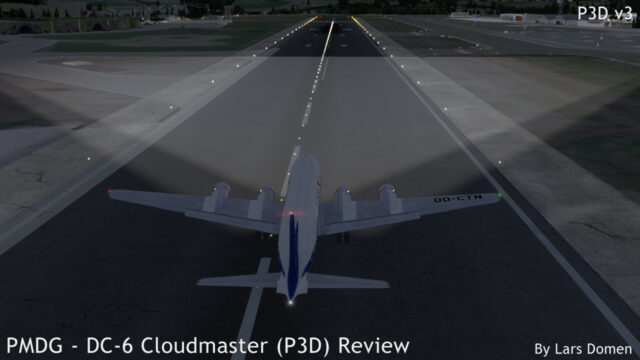

Interior:
The first time looking at the DC-6’s cockpit, you might be overwhelmed by how busy it is. The main instrument panel alone has no less than 35 round needle gauges. The overhead panel has countless more. While there are clear attempts at organizing this workspace, it’s still a long cry away from the ergonomic flight decks of modern airliners. Just look at the position for the flight engineer: a fold-out seat between the captain and first officer.
That being said, PMDG went all the way in modelling this old and busy flight deck. From the gauges themselves to details like the nuts and bolts holding the windows together and even the fasteners affixing the wall lining… It’s all there in 3D. Indeed, the largest items I could find that aren’t 3D modelled, but only drawn in 2D textures, are the chart holders in the sidewalls next to the pilots. Out of sight in normal operations and by their very nature unusable in the simulator.
On top of this very detailed and good looking model, there’s of course a bunch of textures. These textures in general are sharp and detailed looking. In my experience, there are no areas where low resolution textures affect the experience of flying the DC-6. Different materials also have different looks, which is a good thing for immersiveness of the product. Glass looks different than metal, the leather of the glareshield has a different look than the fabric of the seats… All in all, a very pleasant experience.

There are also several things that can be said about the night lighting on the flight deck. First of all, there are a lot of switches, in various places around the cockpit. And all these switches control different lights, in differing colours. There’s both red and white lighting. And this lighting is well reproduced and good looking. Unfortunately, there’s no dimming. It’s either on or off, and for my taste, some of the lights are a bit bright. PMDG’s stance, which is understandable, is that with the amount of detail in this VC, and the number of lights, dimmable lights were not practicable.
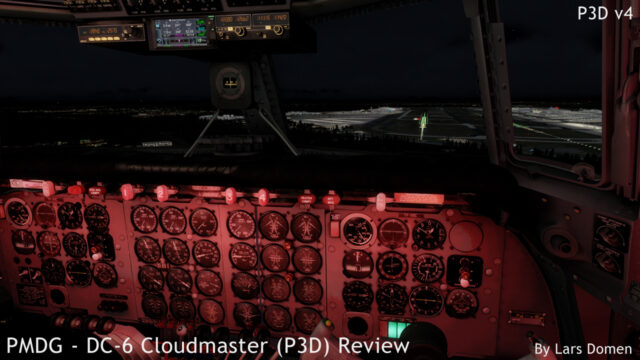

PMDG stayed very close to real life reference aircraft they surveyed in reproducing this aircraft for our simulators. This leads to some surprising details. First of all, by default, the aft centre pedestal of the DC-6 is covered in old-fashioned, non-functional radios. A nice touch, which must’ve taken no little effort in modelling and texturing. But personally, I strongly prefer the clean pedestal included as an option.
Another detail here is that not all gauges are the same. So some engine or fuel gauges, while showing the same thing as their counterparts on other engines, still look different. While this is realistic and adds a touch of character, it might be a bit confusing for new pilots.

Systems:
While the DC-6 is not a marvel of modern technology, it was state of the art in its own time. The focus of the systems in PMDG’s representation is easily summarized: engine management. A very big part of flying the Cloudmaster is managing its engines. Even getting them started can be challenging. Running them for prolonged periods of time without damaging them no less so. You have to keep a close eye on all engine gauges in all stages of flight. And because PMDG made their aircraft’s condition persistent, mishandling the engines on one flight, might affect how well they run on your next flight.
Other systems of note are a detailed electrics system including working circuit breakers, and a fully featured pressurization system, which includes simulating hypoxia. But I personally really like the old fashioned autopilot. No fancy LNAV/VNAV. Not even basic ‘turn to heading’. The autopilot is limited to maintaining attitude, altitude hold, and localizer hold. With localizer hold also able to be coupled to a GPS, if installed. This certainly is not an aircraft in which you turn on the autopilot after takeoff, and just let it do its job until just before landing. You need to be ‘in the loop’ the entire time.

With everything that’s being simulated on this aircraft, I quickly started missing the ability to select and trigger failures on this aircraft during testing. There is stuff that will break if mishandled, especially the engines. But it would be very nice to be able to simulate other failures as well, or have them trigger semi-randomly. Especially fires and electrical failures would be interesting in this regards.
In real life, 3 people are needed to operate this aircraft. To help us armchair pilots out, PMDG includes an Automated Flight Engineer, AFE, in the DC-6. At a prompt by the pilot (you) using a 2D panel, the AFE will take care of his responsibilities, which are mainly everything concerning the engines, including the power settings! A very nice feature which makes starting in the DC-6 a whole lot more accessible. My only gripe is that PMDG never really tells you which engine settings the AFE uses. Sure, you could just work it out by using him and noting the settings, but a bit more info about this in the manual would be nice.

About those manuals: the introduction manual does a good job of getting you started in the simulation that is the DC-6, and the two included tutorials are great in getting you started flying this old propliner. The Pilot’s Operating Handbook was not my favourite manual ever to read through. Despite containing a wealth of information, it also left me wondering about how to handle certain aspects of this aircraft. Certainly for flight planning. There’s loads of planning and performance data included, but not a word on how to use it. Not in the POH, not in the tutorials. At the same time the POH covers other items which I haven’t found useful in the simulator so far, which feels a bit strange. I do have high hopes for the promised third tutorial in regards to more advanced operation of this aircraft, if and when this third tutorials is released.
As for 2D panels, the Cloudmaster comes without full 2D control panels, but has 6 pop-ups used to help set up and handle the aircraft. The first, conveniently mapped to ‘Shift+2’ is a small panel in the top right corner, which lets you access the other popup panels.
I won’t go to deep in these panels, but there are the following:
The Ramp Manager is used to show ground equipment and select the state of your aircraft before your flight.
What the Fuel and Load Manager does is self explanatory. I just wish there was a way to directly set zero fuel weight, instead of fooling around with passenger and cargo numbers.
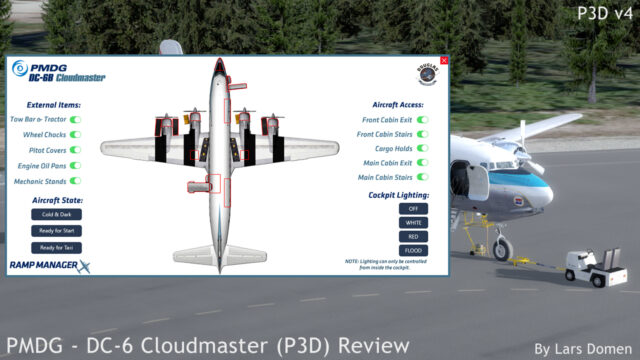
The AFE panel is used to command the AFE to start its next phase, or to disable its functionality if you want to retake full control.
The Maintenance Manager gives you an overview of the state of your engines and their hours since last repair. It also lets you repair the engines or propellers if damaged, and gives you a handy readout of the airframes total hours. Important to note here is that although aircraft state and hours are persistent, they are tracked separately per livery. So a flight (including possible wear and damage) in one livery, does not affect any other livery.

The final panel is the Options panel, and there’s certainly things to be said about it. First there’s a bunch of realism options. Half concerned with the engines, the other half with the autopilot. Turning them off makes the DC-6 easier to come to grips with. Turning them On is more realistic in relation to the real aircraft.
The second column of options concerns the GPS and radios. There are 5 different configurations to choose from. The first three options are available to anyone. A PMDG GNS 430 installed just below the forward overhead, a PMDG GNS 400 installed in the glareshield, or no GPS installed at all, with just the modern Bendix radios for communication and radio navigation. Not bad right out of the box.
The last 2 options are limited to owners of 3rd party GPS add-ons. The PMDG DC-6 supports the Flight1 GNS 430 or the Flight1 GTN 650. I’m quite fond of flying the DC-6 with the GTN 650. A very nice combination. Although you can’t go wrong with the included GPS’s by PMDG of course.



Flight Dynamics:
When first flying her, the DC-6 took me a bit by surprise. It’s an aircraft that definitely requires a pilot to think ahead. Especially when light, the DC-6 is a surprisingly quick climber in takeoff power. When reducing to climb power, and certainly when heavier, it can also be maddeningly sluggish. If it’s heavily loaded, the aircraft will definitely test your patience if you want to both climb and accelerate at the same time.
On the other end of the flight, the Cloudmaster can also be very reluctant to slow down. In order not to torture the engines, they always need to deliver at least a bit of positive power to the propellers. The result is that you really want to plan your descend, and factor in enough room to also slow down. Especially when empty and with little fuel, this can be challenging. I really prefer to fly her loaded down a bit.
While keeping that in mind, the DC-6 is pleasant to fly. Control is crisp and very direct on all axes. In this regard, it almost feels like a small GA aircraft. Although I’m pretty sure the lack of force feedback on most sim setups, including mine, is a big part of that. The combination of this very direct response to control inputs and the need to think about power settings and the vertical flight profile, makes for a unique flying experience. It’s very rewarding once you get used to it.
Sound:
It’s PMDG and it’s a $70 add-on. So there shouldn’t be any problems with sound. And indeed, the PMDG DC-6 Cloudmaster does great in this regard. Every switch in the VC has a distinct sound and all different types of switches sound markedly different, as they should. As soon as you start bringing life to the aircraft, lots of different systems also start making sounds. A very lively place, the DC-6s flight deck.
But of course, in an aircraft driven by 4 18-cylinder, twin row radial engines, it is those engines that truly make the music. And be assured, they do not disappoint. From start-up to shutdown, you get a nice representation of what the R-2800 sounds like. The engine sounds are not ridiculously skewed towards the bass notes as is sometimes the case with sound sets for radial engines. An aspect especially your neighbours might appreciate.
Conclusion:
The PMDG DC-6 Cloudmaster for FSX and P3D is definitely the odd ball in PMDG’s recent line-up of products. It was also a new experience for me as a virtual pilot. It truly challenges its pilots, and gets back to a kind of flying where pilots really had to fly the aircraft, and not manage it. At the same time, the engines really had to be managed, but there was a dedicated crewmember for that job. Trying to fly the PMDG DC-6 entirely on your own, while not very realistic from a real-life viewpoint, is challenging, fun, en extremely rewarding if you get it right. On the other hand, PMDG did a great job in making it more accessible by including a pretty decent Automated Flight Engineer. When not trying to manage this complex airliner, you can admire the good visuals or enjoy the beautiful music those radial engines produce. At the US $69,99 price point though, I’m missing selectable failures, more pleasant to read manuals and more advanced exterior lighting in P3Dv3.
Like:
- Very good visuals inside and out
- Very detailed engine simulation
- Convincing flight model
- Automated Flight Engineer to help you on your way
- Options for a lot of different GPS systems
- PFPX profiles included
Don’t Like:
- No selectable failures
- Default landing lights in P3Dv3
- Room for improvement in the documentation
Useful Links:
Intel Core i7-6700K @ 4x4GHz (stock speed)
32GB DDR4 RAM
Asus GTX 1070 Strix Gaming 8G
Windows 10 64 bit
Prepar3D v3.4
Prepar3D v4
Software Used:
Active Sky 2016, Active Sky for P3D4 and Active Sky Cloud Art
Aerosoft Andras Field
Aerosoft Bergen X
Flight 1 GTN Complete Edition
FSFX Packages PrecipitFX
Orbx FTX Global
Orbx FTX Norway
Real Environment Extreme Texture Direct + Soft Clouds
Ultimate Terrain X Europe v2
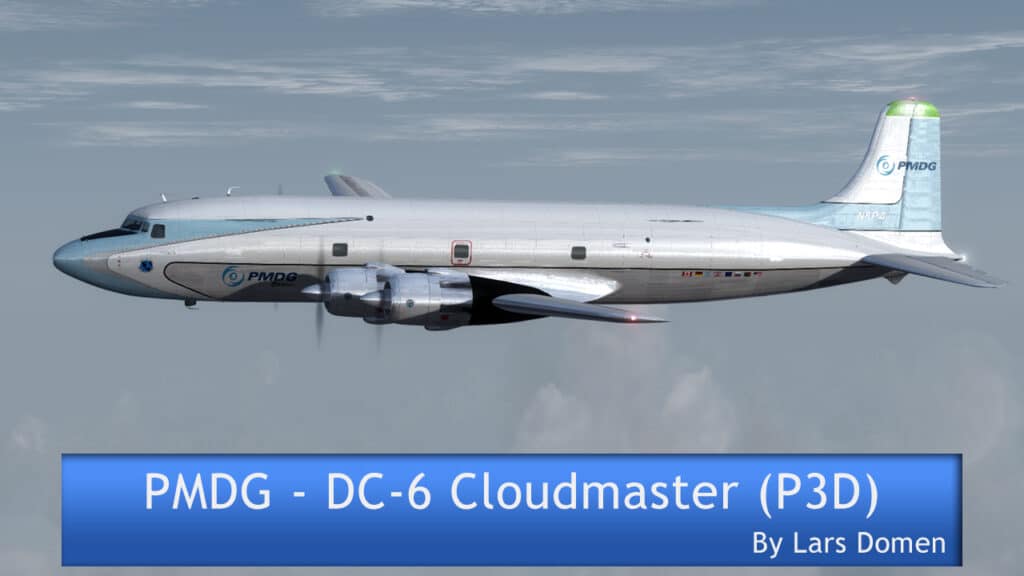
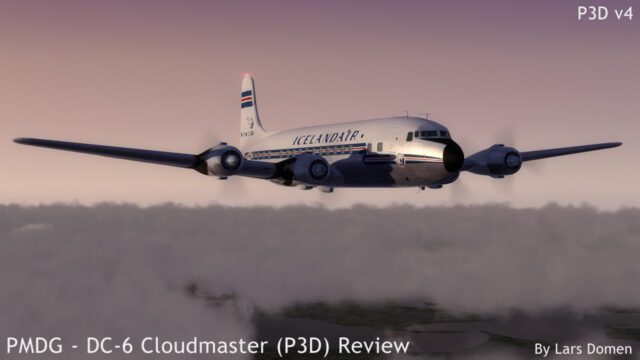








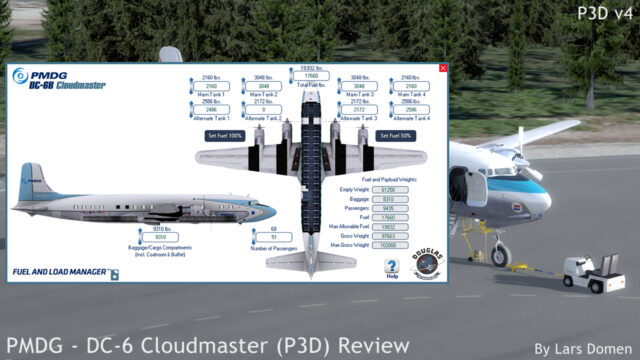




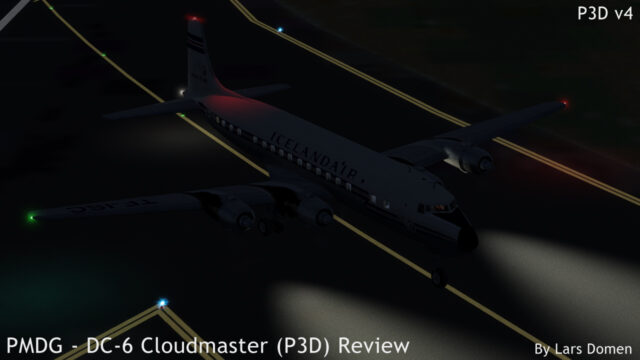





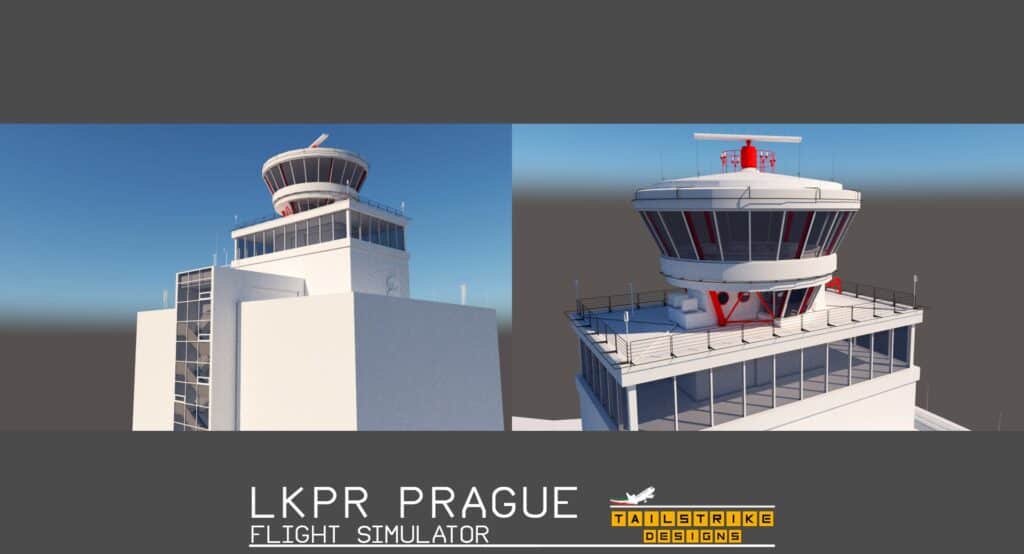
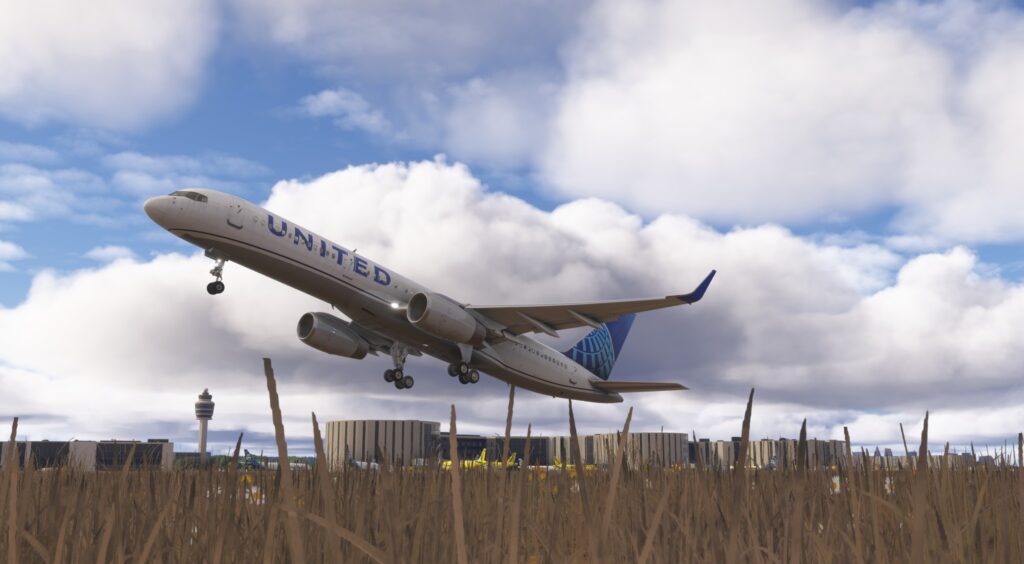
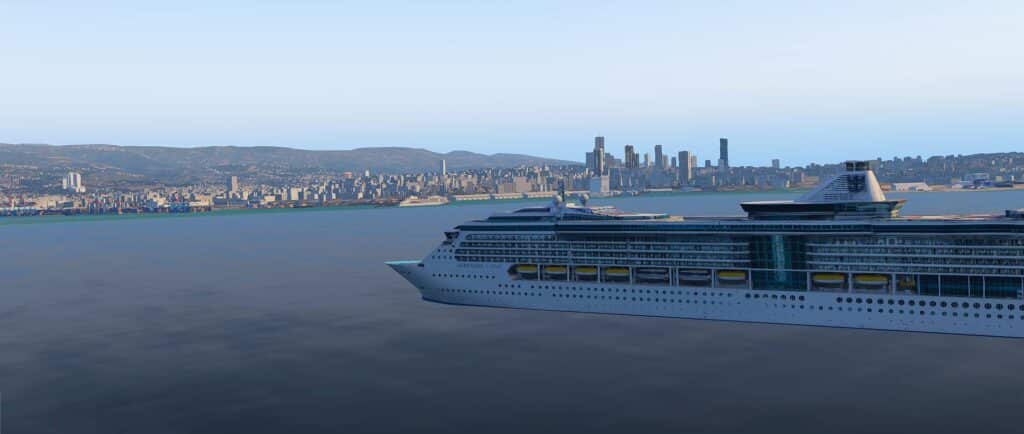

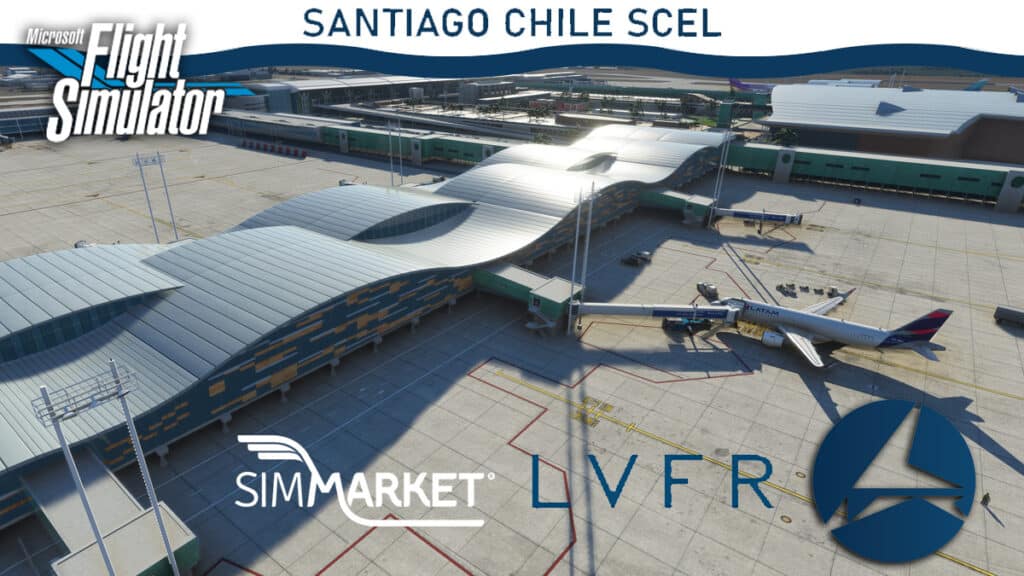
Personally I find this review a bit too positive. While most sounds are really good, especially the engines, others are completely missing. Ground roll, touchdown, rattle sounds are completely missing, also the aux blower and the heating sounds.
Windows won’t fog up. Engines are not dynamically simulated, every engine start is the same, regardless of oil temperature. The superchargers are incorrectly modeled. The cabin is silent all the time.. No stewardess coming up to the cockpit time to time.. These are items that would be fully ok for some midprize product, but for a fullprice PMDG addon I just expect that to be included. While PMDG is really ahead in regards of visuals and engine sounds, they cannot come up with an immersion experience found on the A2A COTS addons (Connie/ Stratocruiser) by far. I really hope a future SP will address at least the most important items.
I agree. I have purchased PMDG products in the past and got many hours of enjoyment out of them. However the latest stuff just seems so flaky, overpriced and it seems PMDG are just going through the motions and relying on there once great reputation. They have the industry sewn up tight. No one will dare give them a bad review simply because of the backlash from the somewhat blind fan base.
Phil,
Are you implying that I purposely write misleading reviews in order to stay in PMDG’s good graces? The amount of time and effort spent on reviewing a product like this is not small. And I’d get a whole lot more monetary value for my time and effort if I just spent in reviewing the next random airport add-on, despite them being much cheaper… A lot easier to do those.
I’ll agree that the DC-6 is not PMDG’s best or most revolutionary product ever. And I wholeheartedly agree that their stuff is overpriced. But it always has been, and the same can be said about products from numerous other developers. FSLabs, Majestic, even Carenado,… Just to name a few.
I do not agree with your statement about their latest stuff being flaky. Every product has bugs and problems, and I’ve seen PMDG do worse in terms of responding to that than with the products they released this year.
Are they now bug free? No. Will they ever be? I’d wager not. I also remember PMDG is not the best when it comes to releasing (promised) big service packs after an initial round of fixes.
That beings said, I stand by my review. But I’ll look at it AGAIN later and see if there’s things I feel the need to clarify further.
Regards,
Lars
I just think he ment you probably were a little more on the positive side, not to please PDMG but not to “offend” PMDG fans wich seems to go defensive as soon as you say something “wrong”.
One one implied you cheated and the review I much appreciated.
I find the review to be very fair and thoroughful.
But I wished it had gone a bit deeper on the engine modelling, cause on propairliners proper engine management is very important.
Had it not been for the exisitance of the A2A prop-airliners, I would have felt that the PMDG DC-6B was very nicely modelled.
But fact is that the A2A airliners exist and has set the bar for how deep engine modelling can be done in FSX/P3D and the PMDG DC-6B falls short on this (for me) very important point.
Normally PMDG is well known for very deep simulation of aircraft systems, but with the DC-6B I feel that is has been some kind of a sideline project.
Also asking into this im their support forum triggers the usual f a n b o y rage and improper feedback from the moderators.
For me it´s acceptable if they simply lay down flat and admit that the engine modelling isn´t something they wanted to put the same effort into as seen on the A2A models, becuasse the DC-6B is not bad at all, just lagging where others shine and vice versa.
FinnJ
Thank you for your well-thought-out comment Finn.
I wasn’t implying that you purposely wrote a misleading review. I was looking at it in the broader sense. The other comments seem to get what I was talking about. It seems there is an atmosphere and environment that is challenging to criticize anything PMDG does.
I mean just look where this got us 🙂
Thank you for your comment Phil.
And I’m sorry for possibly overreacting a bit to the first one. Unfortunately plain text still doesn’t lend itself all too well to conveying the exact meaning of some statements that can be interpreted in several ways.
I might’ve overreacted a bit because, for me, this was not an easy review to write in any way. Not my usual style of aircraft, for one thing. 😉
There indeed is a very vocal (although I hope small) group on the PMDG forums that doesn’t allow anything less then amazingly positive to be said about anything they do.
Matthias,
Thank you for your feedback.
I agree with the points you make. However, you’re directly comparing the PMDG DC-6 with the A2A CotS birds, which I purposely didn’t do in my review. For one thing, because I don’t own a license for those add-ons.
The features you mention are all part of the ‘Accusim’ or ‘Captain of the Ship’ part of A2A products. While those are now an integral part of the base products A2A sell, that used to be different.
I know A2A’s products, they are awesome indeed. But PMDG is not A2A.
I think the only real comparisons you can make, is in regards to value for money and immersiveness. And in those aspects, from what I’ve seen, I might agree that A2A’s CotS products do better than this PMDG DC-6.
Regards,
Lars
For a product in the same league as the A2A Prop-airliners that comes without the COTS features, I would at least have expected to see the Engines being better simulated.
The Engine startup seems scripted. Going through the exact procedure for engine start, the engines always start on the “12-Blade” count, regardless of amount of priming, outside temperature, engine temperature etc. Sparkplug fouling also seems absent as well as other parts of realistic engine behaviour. All something that takes away part of the immersion.
Also the absence of old style radios reduces the DC-6th value for me compared to the A2A Airliners.
Just my humble opinion..
Finn